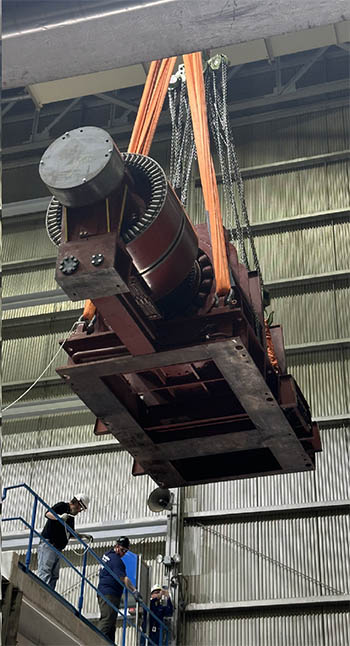Returning Palisades to service
The Palisades nuclear power plant in Covert Township, Michigan, USA, consists of a single 805 MWe pressurized water reactor that was acquired by Holtec from its then-owner and operator, Entergy, in June 2022. Just over a month before its acquisition, the plant was shut down, having generated more than 230 TWh over the course of its 50 years of service.
At that time, it was intended to dismantle, decontaminate and remediate the plant by 2041. However, following strong local, state and federal support, Holtec announced plans to apply for federal funding to enable it to reopen the plant. In March 2024 the US Department of Energy (DOE) Loan Programs Office conditionally committed up to $1.52 billion for a loan guarantee. Holtec has to satisfy certain technical, legal, environmental, and financial conditions before the DOE enters into definitive financing documents and funds the loan, which is anticipated to occur in the summer of 2024.

Lifting the Exciter (Image: Holtec)
As part of the steps towards the restart of the plant, Holtec has increased staffing by over 225 professionals, including both new hires and returning former plant employees. Holtec is also reconstituting training facilities, including rebuilding the control room simulator, submitting regulatory documents, securing a power purchase agreement and is ordering new fuel and long-lead components.
Plant work is also underway, including the offsite refurbishment of the generator exciter and restoration of reactor vessel’s operational integrity in preparation for a deep chemical cleaning of the plant’s reactor cooling system. Upcoming actions include inspection of the reactor vessel internals and steam generators.
Holtec is currently targeting a late 2025 restart of the reactor, with generation until 2051 under consideration – which would require applying for a subsequent licence renewal.
Interview: Patrick O’Brien, Director, Government Affairs and Communications, Holtec

What benefits would the repowering of Palisades offer the local community?
There are many benefits of repowering the facility. When online the facility supports roughly 600 full-time, high-paying jobs during regular operation, with a large union workforce. Additionally, it brings an additional 1000+ specialty workers to southwest Michigan for regularly scheduled refuelling and maintenance outages every 18 months.
The facility is one of the region’s largest taxpayers supporting local public schools and libraries, public safety, transport, veterans and senior services. A 2023 study by the Economic Growth Institute at the University of Michigan determined that the premature shutdown of Palisades resulted in an annual loss of $259 million in labour, income, and value added for the tri-county region alone. Bringing this economic benefit to the area is essential. For Michigan it provides carbon-free generation to achieve its climate goals, maintain reliability, and attract future employers, which will further increase the economic benefits for the region.
What are the main challenges in restarting Palisades and how are they being addressed?
The restart process has been quite complex. Initially the main challenge was gaining the support to resume operations, and for Palisades this was actually something the state of Michigan pushed hard for and allowed us the look at the concept of repowering, which has never occurred for a plant that had been shut down prior to being decommissioned. There have been instances of plants having multi-year shutdowns before a restart so, from a physical plant perspective, that challenge has been overcome at other sites in the USA.
Identifying the funding – a mix of federal, state, and Holtec – was vital, and was initially rejected when we failed to get the DOE’s Civil Nuclear Credit funding, before turning to the DOE Loan Program Office.
Rehiring or hiring up to 400 people back to the site to assist the 220 that had remained for decommissioning continues to be a challenge in ensuring that we have the best staff to accomplish the goal.
Securing a power offtaker was the next challenge and working with our partners at Wolverine and Hoosier Power this was accomplished at a price that ensures our ability to repay the DOE loan.
Another ongoing challenge is developing the correct scope of work and ensuring the systems and material condition of the plant will be ready for the restart, and to allow for a long-continued operation of the facility.
Finally, we continue to work through the challenge of obtaining a licence from the Nuclear Regulatory Commission (NRC) to restart the facility. With the regulatory oversight and public input processes, we expect this to continue into 2025, but ultimately we expect to have a success path with the proper oversight and public input.
When do you plan for the reactor to re-enter service, and for how long could it operate?
Our target is to have the facility back online producing clean power by October 2025. The facility is currently licensed to 2031, with an option for an additional 20-year extension, which will be pursued after we recommence operation.
Holtec intends to build its first two small modular reactors (SMRs) at Palisades.
What are the pros and cons of constructing those SMRs on a site with an active reactor, rather than one that is being decommissioned?
The benefits of building at an existing plant, either operating or undergoing decommissioning are the same. You have an educated local community on the benefits of nuclear power and a trained workforce to support the plant operations. Additionally, the sites have pre-existing security plans, known environmental impacts/studies, and energy infrastructure like interconnection to the grid.
We don’t see many downsides and feel the long history of nuclear power at these sites is a major benefit to initial deployment. The biggest potential downside would be to let the infrastructure and highly skilled personnel go to waste by not continuing generation at these sites.